Note that all images and video presented here are copyright protected and may not be copied or shared for commercial purposes
Basic system
The network is based on the AllSky7 systems manufactured by Mike Hankey. Details about the systems were published in a paper at Meteoroids 2020 conference.
Each system contains seven highly sensitive NetSurveillance NVT cameras with the SONY STARVIS IMX291 CMOS Sensor and a 4 mm f/1.0 lens. Five of them are horizonally oriented at an altitude of about 25°, camera six and seven point in northern and southern direction at an altitude of about 70° All together they cover the full sky down to the horizon.
Each camera has a field of view of about 45x80°. The cameras are recording at 25 fps and reach a limiting magnitude of about 4 mag. Maximum resolution is 25 pixel/°.
Beside the cameras, the dome contains a power supply and an ethernet switch for each camera. Each camera has a black paper baffle. The dome is painted from the inside with two color layers - silver outside and pale black inside. That reduces internal reflections and the thermal influx.
Power is supplied via Power-over-Ethernet (PoE), so that the whole system needs just one CAT-6 Ethernet cable to connect it to base computer. The computer is a barebone Mini PC running Ubuntu and the AllSky7 software by Mike Hankey, which is continuously improved. Each camera provides an SD (704x576 pixel) and HD (1920x1080 pixel) video stream which are recorded by the Mini PC and analysed asynchronously.
The camera is recording meteors and fireballs 24/7, but at the moment only the nighttime recordings are automatically analysed. About 5.000 meteors are recorded per year under typical central European conditions.
The software provided by Mike Hankey covers all aspects of the measurement of fireballs. It allows to sort out false detections from the daily meteor stack, to measure the position of fireballs in single video frames, to identify reference stars and do the astrometry and photometry of the recording, and to combine the observation with data from other camera stations to calculate trajectories and orbits. The software comes free of charge for all members of the AllSky7 Firebal Network (community license). All software functions are shown in a short advertising film.
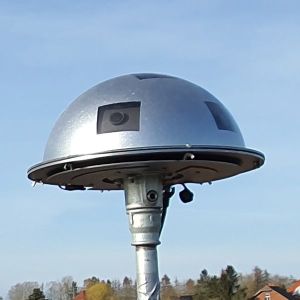


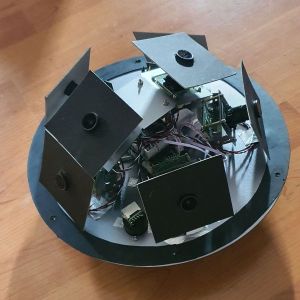
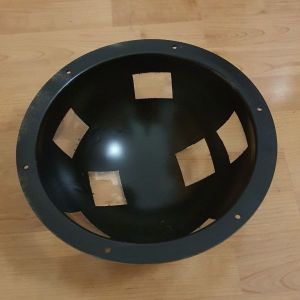

AllSky7+
In 2022 we upgraded the system to AllSky7+ by adding an 8th camera with a 1.13mm fisheye lens on top. This camera records the full sky at once and provides improved photometry and astrometry of particularly bright fireballs.

AllSky7+ HS
In 2024 we switched to an high sensitivity (HS) edition by replacing the Sony IMX291-based with an IMX307-based camera. This sensor reaches higher sensitivity by improved noise reduction and yields superior performance in particular for stationary objects (e.g. stars, aurorae). This can be seen best during twilight, when the images still look like day-time recordings.
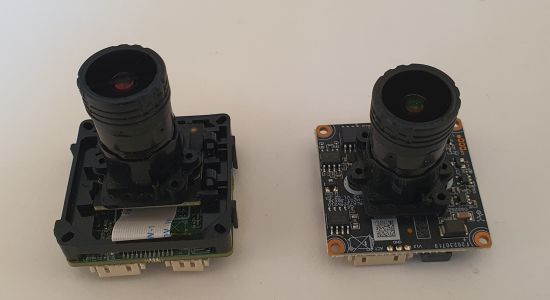
AS7 Sensor Board
Starting from 2025, new system are equipped with a AS7 Sensor Board (AllSky7+ HS SB). This boards provides precise timing (1PPS) and geo-location, but also temperature and humidity inside and outside the dome. The sensor board comes optionally with a relay that can control a fan, heating device or cooling device, or any other system added by the camera operator, based on the climate inside and outside the dome. The sensor board provides additional digital ports for custom extensions.
Click here for further details.
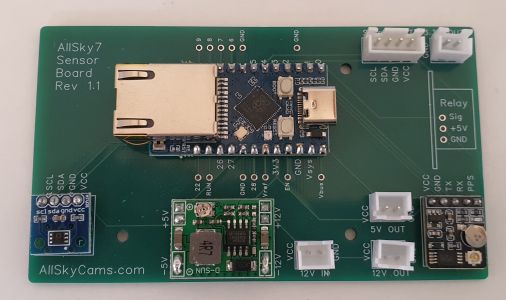
AS7 Health Checker
Click here for further details.

The primary goal of the AllSky7 network is to record meteors and fireballs. However, since our cameras record the full sky 24 hours a days / 365 days a year, we record also other rare, curious, strange or simply pitoresque events. Here is a collection of such events. You can filter them by distance from the camera.
If you want to contribute to the AllSky7 Fireball Network and operate your own camera, please get in touch with Mike Hankey if you reside outside the EU, or Sirko Molau if you are an EU resident.
Of course, you can also contribute to the network without owning a camera yourself. The easiest way to join the community and learn about ongoing projects, updates, latest observations and other topics, is to subscribe to our announcements mailing list (announcements@allsky7.groups.io) and to our German (german@allsky7.groups.io) and/or English (english@allsky7.groups.io) subgroups.
If you have a technical question about the network, you may contact the AllSky7 Support Team.
We aim at locating camera station at 100 to 150 km distance from each other to maximize the scientific output. There are two options of camera donations:
- If you just want to support this initative, without wanting to operate a camera on your own, you can
donate an arbitrary amount of money to
Arbeitskreis Meteore e.V.. AKM is a German non-profit organization supporting citizen science
and education of meteors and atmospheric phenomena. Just mark your donation with "AllSky7" and the money will be spent 100% to extend this network.
You will receive a donation receipt that you can use for your tax declaration.
- If you are living in an area which is already well covered by the network, you can get a remote AllSky7 station. You pay for the camera
at it is your own property. However, it will be installed by another European amateur astronomer whose observing site extends the network perfectly,
but who cannot afford the camera on his own. Both parties sign a contract which is available in
German and
English.
If you are interested to become a donator or receiver of a remote camera, please get in touch with Sirko Molau.
The AllSky7 Fireball Network is a loose consortium of owners of AllSky7 fireball cameras with the purpose of
- popularizing astronomy and atmospheric phenomena, in particular meteors, fireballs and meteorites,
- supporting scientific analyses of these phenomena, and
- public education and spread of information, data and recordings of these events in the public.
The camera network has a charitable character and does not follow commercial interests.
All network members agree to terms and conditions of the network, which are drafted in
English and
German
and updated regularly.
Meteorite-dropping fireballs and meteorites are handled by the AllSky7 Meteorite Working Group (AS7 MWG),
which has its own terms and conditions drafted in
English and
German.
The recordings and data of the camera network can be downloaded and used in accordance to the purpose of the network. That includes:
- the scientific analysis of the observations alone or in combination with other recordings to improve algorithms, calculate trajectories, orbits, meteoric strewn fields and other characteristics,
- the non-commercial distribution of data and recordings in the Internet (e.g. at the website of the network, the camera owner, AKM, IMO, or other astronomical organizations), in social networks (e.g. Youtube, Facebook) and in classical media (e.g. TV, print media), and
- the distributions of data to research facilities, observatories and other non-commercial parties.
In spite of the granted permissions, the copyright remains with the camera owner. Every use requires that the AllSky7 Fireball Network, the name of the camera owner and the copyright is mentioned.
Scientific publications have to contain the following sentence in their acknowledgements:
All [Part of] the work presented here is based on data of the AllSky7 camera network. The authors thank the network operators for making their data available.As reference, you may use the Meteoroids 2020 paper of Mike Hankey.
If individual recordings or data are published, they have to contain the copyright note (incl. link):
Copyright: <camera owner>, AllSky7 Fireball Network.
